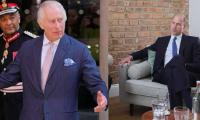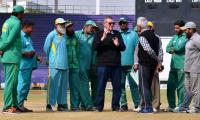ISLAMABAD: A qualitative distinction is discernible between the efforts being made by the Imran Khan government to avert the Azadi March now and the attempts put in by the Nawaz Sharif regime back in 2014 to obviate the sit-ins at the same strategic venue – D Chowk of Islamabad.
One difference is that the present administration has formally constructed a team of negotiators that has held the first round of talks with the senior leaders of the multiparty opposition grouping. Last time, no official lineup was chosen to initiate dialogue with the leaders of the sit-ins’ sponsors - Pakistan Tehreek-e-Insaf (PTI) and Pakistan Awami Tehreek (PAT). Absolute reliance was made on long-drawn backdoor contacts, and the then Interior Minister Chaudhry Nisar Ali Khan, being an old friend of Imran Khan, was the principal point man in this regard. It is now learnt through a credible source that Ahsan Iqbal, who was a minister in the Nawaz Sharif cabinet, had also held a meeting with senior PTI leader Jehangir Tareen at the latter’s residence to find a way to prevent the sit-in. This session was always kept under the wraps. However, much before the PTI-PAT agitation started in August 2014, the then prime minister, sensing the protest being organised, accompanied by some close aides had met Imran Khan at the latter’s Bani Gala residence in March. The objective behind the gesture was to soften the PTI chairman’s attacking stance towards the government. Chaudhry Nisar had prevailed upon Nawaz Sharif to visit the PTI chief and had also worked out the details of the meeting. He had accompanied the premier.
Apart from Imran Khan for having good bonding with him, Chaudhry Nisar had also been in touch with the then Khyber Pakhtunkhwa Chief Minister Pervaiz Khattak. His acquaintance with both dated back to their days in the Aitcheson College Lahore. In the beginning, the name of the then Speaker, Sardar Ayaz Sadiq, was mentioned as one of the official interlocutors, but it was dropped so that his role as a “neutral” person is not affected. The purpose of protracted behind the scenes talks was to persuade the PTI from abandoning the idea of protest. The then government had preferred not to engage the PAT in the negotiations. Contrary to the past, the current government has formed its team, though very belatedly, just a week before the beginning of the Azadi March from Sukkur on Oct 27. Before that, the government leaders remained locked with the opposition stalwarts, daring the sponsors of the protest to come and agitate. Only two days before the departure of the marchers from their starting point, the government team held the maiden session with the other side that ended in a deadlock. There is remarkable similarity and resemblance between the arguments being given by the Nawaz Sharif government five years back and the instant administration now to change the venue of the protest and the disastrous consequences of the mayhem on the national economy and other aspects of life. There is only reversal of roles with the assertions and pleas to guard the national interest and save Pakistan from a bad international name remaining fundamentally the same. The refrain was and is that the homeland is confronted with multiple alarming challenges from inside and outside and any anarchy would aggravate them. The sponsors of the previous protest had not cared two hoots about the calls for sanity and the present agitators have extended no different approach either. They are and have been of the view that the change of government is the only answer to pull Pakistan out of the morass.
Another glaring contrast is that the powerful circles who matter in the scheme of things were not with the government in 2014, while now they are with the government. Another difference is that last time the PTI members of the National Assembly had resigned from their seats, which worsened the crisis. However, the Speaker had not accepted them and kept them pending. Finally when the sit-ins were wrapped up the resignations were withdrawn. At present, there is no such move from the opposition parties. In 2014, there was an intense wrangling between the protest sponsors and the government about the venue. Same heated arguments are going on now regarding it.
Earlier, the government had asked the agitators to stage their show at the Parade Ground, F-9 Park or any other place of their choosing and finally agreed to allow it at the Zero Point. However, the protesters forced their way into the D Chowk, throwing away all hurdles and containers. The government had also made it clear that under no circumstances it would let the Azadi March to be held at the D Chowk. Similar arguments were given by the government team last night insisting that come what way it would not allow the protest to be held at D Chowk. The law will take its course, and had been the repeated ominous warning to the protesters. However, a stark similarity is that hundreds of containers were brought in Islamabad and Rawalpindi in 2014 and the same has been done at a more major scale now as such barricades have been put in place in several other cities in Punjab, Sindh and Khyber Pakhtunkhwa. This has left a negative impact on the exporters and importers. A participant of Friday night’s government-opposition parleys told The News that two members of the official team read out two judgments of the Supreme Court and Islamabad High Court (IHC), forbidding any protest at the D Chowk. However, they were told by the other side that the PTI should not refer to them because it doesn’t accept the judges, who had handed down these verdicts. Its government had filed a reference against one of them, Justice Qazi Faez Isa, while the other, Shaukat Siddiqui, has been ousted from the IHC.
According to the participant, the approach of acting president and Senate Chairman Sadiq Sanjrani, who was a member of the government squad, is very positive as he wants a solution. Formal communication channels are open, working to preclude the crisis as the government team again contacted the rival side on Saturday. One of the major sticking points is the venue of the forthcoming protest.
The IHC directed the investigating officer to appear before the court on the next date of the hearing
Shahzad claims that in October 2023, he was informed by his acquaintances that Pakistan High Commission in London was...
PTI spokesperson pointed out that the farmers were bearing the brunt of the government’s wrong decision
The Khalistan Referendum voting campaign is being organised under the supervision of the independent Punjab Referendum...
Aramco’s acquisition indicates a significant milestone in Pakistan’s energy sector
It is estimated that over 1 million tablets of the drug are sold illegally in Pakistan







